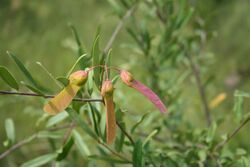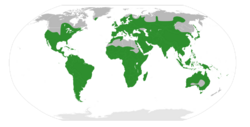Biology:Polygalaceae
| Polygalaceae | |
|---|---|

| |
| Securidaca longipedunculata | |
| Scientific classification | |
| Script error: No such module "Taxobox ranks".: | Plantae |
| Script error: No such module "Taxobox ranks".: | Tracheophytes |
| Script error: No such module "Taxobox ranks".: | Angiosperms |
| Script error: No such module "Taxobox ranks".: | Eudicots |
| Script error: No such module "Taxobox ranks".: | Rosids |
| Script error: No such module "Taxobox ranks".: | Fabales |
| Script error: No such module "Taxobox ranks".: | Polygalaceae Hoffmanns. & Link[1] |
| Type genus | |
| Polygala | |
| Tribes | |
|
See text. | |

| |
| Distribution of the Polygalaceae | |
| Synonyms | |
| |
The Polygalaceae or the milkwort family are made up of flowering plants in the order Fabales. They have a near-cosmopolitan range, with about 27 genera and ca. 900 known species[2] of herbs, shrubs and trees. Over half of the species are in one genus, Polygala, the milkworts.
The family was first described in 1809 by Johann Hoffmansegg and Johann Link.[3] In 1896, Robert Chodat split it into 3 tribes. A fourth tribe was split off from the tribe Polygaleae in 1992.[4] Under the Cronquist classification system, Polygalaceae were treated in a separate order of their own, Polygalales. Currently, according to the Angiosperm Phylogeny Group, the family belongs in Fabales.
Description
Polygalaceae are annual or perennial herbs, shrubs, shrublets, and small trees. Its zygomorphic, hermaphrodite, bisexual flowers have 3-5 petals and 5 sepals.[5][6] Its leaves are usually alternate, but may be opposite, fascicled, or verticillate.[5] Each flower usually contains 8 stamens, though this may range from 3 to 10. They are usually in 2 series.[6] The fruits of each plant can be a capsule, samara, or drupe.[5]
Tribes and genera
The Polygalaceae comprise the following genera,[5] with tribes based on various sources.[7][8][9][10][11][12]
- Carpolobieae Eriksen
- Atroxima Stapf
- Carpolobia G. Don
- Moutabeae Chodat
- Barnhartia Gleason
- Diclidanthera Mart.
- Eriandra P. Royen & Steenis
- Moutabea Aubl.
- Polygaleae Chodat
- Acanthocladus Klotzsch ex Hassk.
- Asemeia Raf.
- Badiera DC.
- Bredemeyera Willd.
- Caamembeca J.F.B. Pastore
- Comesperma Labill.
- Epirixanthes Blume
- Gymnospora (Chodat) J.F.B. Pastore
- Hebecarpa (Chodat) J.R. Abbott
- Heterosamara Kuntze
- Hualania Phil.
- Monnina Ruiz & Pav.
- Monrosia Grondona
- Muraltia DC.
- Phlebotaenia Griseb.
- Polygala L.
- Polygaloides Haller
- Rhamphopetalum J.F.B.Pastore & M.Mota
- Rhinotropis (S.F. Blake) J.R. Abbott
- Salomonia Lour.
- Securidaca L.
- Xanthophylleae Chodat
- Xanthophyllum Roxb.
- Other genera
- Trigoniastrum Miq.
Fossils
- †Deviacer Manchester
- †Paleosecuridaca Pigg, Kathleen B., M.L. DeVore & M.F. Wojc. 2008
Systematics
Modern molecular phylogenetics suggest the following relationships:[12][13][14][15][16][17]
| ||||||||||||||||||||||||||||||||||||||||||||||||||||||||||||||||||||||||||||||||||||||||||||||||||||||||||||||||||||||||||||||||||||||||||||||||||||||||||||||||||||||||||||||||||
References
- ↑ Angiosperm Phylogeny Group (2009). "An update of the Angiosperm Phylogeny Group classification for the orders and families of flowering plants: APG III" (PDF). Botanical Journal of the Linnean Society 161 (2): 105–121. doi:10.1111/j.1095-8339.2009.00996.x. http://onlinelibrary.wiley.com/doi/10.1046/j.1095-8339.2003.t01-1-00158.x/pdf. Retrieved 2013-07-06.
- ↑ Christenhusz, M. J. M.; Byng, J. W. (2016). "The number of known plants species in the world and its annual increase". Phytotaxa 261 (3): 201–217. doi:10.11646/phytotaxa.261.3.1. http://biotaxa.org/Phytotaxa/article/download/phytotaxa.261.3.1/20598.
- ↑ "Polygalaceae". https://www.ipni.org/n/30000688-2.
- ↑ Eriksen, Bente (1993). "Phylogeny of the Polygalaceae and its taxonomic implications". Plant Systematics and Evolution 186 (1/2): 33–55. doi:10.1007/BF00937712. ISSN 0378-2697.
- ↑ 5.0 5.1 5.2 5.3 "Polygalaceae Hoffmanns. & Link". Plants of the World Online. Royal Botanic Gardens, Kew. https://powo.science.kew.org/taxon/urn:lsid:ipni.org:names:30000688-2.
- ↑ 6.0 6.1 "Polygalaceae". Government of Victoria, Australia. https://vicflora.rbg.vic.gov.au/flora/taxon/c812c37c-2c1e-4bde-871a-75827877f679.
- ↑ Abbott JR. (2011). "Notes on the disintegration of Polygala (Polygalaceae), with four new genera for the flora of North America". Journal of the Botanical Research Institute of Texas 5 (1): 125–137.
- ↑ Pastore JFB. (2012). "Caamembeca: Generic status and new name for Polygala subgenus Ligustrina (Polygalaceae)". Kew Bull 67 (3): 435–442. doi:10.1007/s12225-012-9360-x.
- ↑ "Generic status and lectotypifications for Gymnospora (Polygalaceae)". Novon 22 (3): 304–306. 2013. doi:10.3417/2010113. http://www.botanicus.org/page/2531694.
- ↑ "Preliminary synopsis of the genus Hebecarpa (Polygalaceae)". Kew Bull 70 (3): 39. 2015. doi:10.1007/s12225-015-9589-2.
- ↑ Freire-Fierro A. (2015). Systematics of Monnina (Polygalaceae) (Ph.D.). Drexel University. Archived from the original on 2017-03-19. Retrieved 2017-03-19.
- ↑ 12.0 12.1 "A molecular phylogeny and taxonomic notes in Caamembeca (Polygalaceae)". Syst Bot 42 (1): 54–62. 2017. doi:10.1600/036364417X694935.
- ↑ Persson C. (2001). "Phylogenetic relationships in Polygalaceae based on plastid DNA sequences from the trnL–F region". Taxon 50 (3 (Golden Jubilee Part 5)): 763–779. doi:10.2307/1223706.
- ↑ "The role of biotic and abiotic factors in evolution of ant dispersal in the milkwort family (Polygalaceae)". Evolution 61 (7): 1675–1694. 2007. doi:10.1111/j.1558-5646.2007.00138.x. PMID 17598748.
- ↑ "Elusive relationships within order Fabales: Phylogenetic analyses using matK and rbcL sequence data". Syst Bot 34 (1): 102–114. 2009. doi:10.1600/036364409787602348.
- ↑ Abbott JR. (2009). Phylogeny of the Polygalaceae and a revision of Badiera (PDF) (Ph.D.). University of Florida.
- ↑ "Evolution of mycoheterotrophy in Polygalaceae: The case of Epirixanthes". Am J Bot 102 (4): 598–608. 2015. doi:10.3732/ajb.1400549. PMID 25878092.
Wikidata ☰ Q156360 entry
 |
